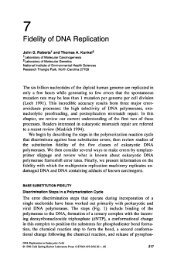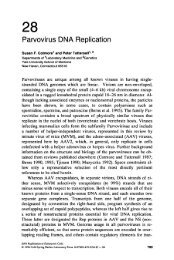Chapter 36: DNA Replication in Xenopus (PDF)
Chapter 36: DNA Replication in Xenopus (PDF)
Chapter 36: DNA Replication in Xenopus (PDF)
Create successful ePaper yourself
Turn your PDF publications into a flip-book with our unique Google optimized e-Paper software.
978 J.J. Blow and J.P.J. Chong<br />
cycl<strong>in</strong> A<br />
cdc2<br />
cycl<strong>in</strong> B<br />
cdc2<br />
Figure 3 Cartoon show<strong>in</strong>g the proposed roles of cycl<strong>in</strong>s A, B, and E <strong>in</strong> <strong>Xenopus</strong><br />
egg extracts. The top panel shows the cell-cycle events tak<strong>in</strong>g place <strong>in</strong> <strong>Xenopus</strong><br />
extracts. K<strong>in</strong>ase activities of cycl<strong>in</strong> A-cdc2, cycl<strong>in</strong> B-cdc2, and cycl<strong>in</strong> E-cdk2 at<br />
the different times are shown by the boxed regions below. In the presence of<br />
cycloheximide, levels of cycl<strong>in</strong>s A and B rema<strong>in</strong> low, whereas cycl<strong>in</strong> E is largely<br />
unaffected. See text for more details. MPF (stippled) and SPF (diagonal l<strong>in</strong>es)<br />
activities associated with these k<strong>in</strong>ases are also <strong>in</strong>dicated; SPF activity of cycl<strong>in</strong><br />
E-cdk2 dur<strong>in</strong>g mitosis is undeterm<strong>in</strong>ed. (Redrawn from U.P. Strausfeld et al., <strong>in</strong><br />
prep.)<br />
<br />
On exit from mitosis <strong>in</strong> <strong>Xenopus</strong>, cycl<strong>in</strong> A but not cycl<strong>in</strong> E is degraded<br />
(M<strong>in</strong>shull et al. 1990; Gabrielli et al. 1992; Rempel et al. 1995), so that<br />
extracts prepared <strong>in</strong> the presence of prote<strong>in</strong> synthesis <strong>in</strong>hibitors conta<strong>in</strong><br />
no cycl<strong>in</strong> A, and all SPF activity is provided by the cdk2-cycl<strong>in</strong> E complex<br />
(Fig. 3). However, cycl<strong>in</strong> A is abundantly translated and can form<br />
an active k<strong>in</strong>ase with cdc2 (M<strong>in</strong>shull et al. 1990) to provide additional<br />
SPF activity (Strausfeld et al. 1994 and <strong>in</strong> prep.). Cycl<strong>in</strong> A is capable of<br />
<strong>in</strong>duc<strong>in</strong>g <strong>DNA</strong> synthesis even when added after nuclear assembly is<br />
complete (U.P. Strausfeld et al., <strong>in</strong> prep.), and its role may be to <strong>in</strong>duce<br />
<strong>in</strong>itiation at any replicons that have not already fired. Consistent with<br />
this, <strong>DNA</strong> replication <strong>in</strong> translationally active sucl-depleted extracts<br />
(which are likely to conta<strong>in</strong> significantly more cycl<strong>in</strong> A than E) is more<br />
efficiently restored by addition of cdc2 mRNA than by cdk2 mRNA<br />
(Chevalier et al. 1995). As cycl<strong>in</strong> A and cycl<strong>in</strong> B k<strong>in</strong>ase levels build up<br />
later <strong>in</strong> the cell cycle, this becomes sufficient to <strong>in</strong>duce entry <strong>in</strong>to mitosis.<br />
Correct passage through mitosis is necessary for <strong>DNA</strong> to become relicensed<br />
for <strong>DNA</strong> replication <strong>in</strong> the next cell cycle (Blow and Laskey<br />
1988; Blow 1993). The coord<strong>in</strong>ation of the different cdks is therefore<br />
responsible for the regulated replication of <strong>DNA</strong> dur<strong>in</strong>g the cell cycle.






